
 When you see this symbol, click to read related discussion in the Forum. When you see this symbol, click to read related discussion in the Forum.
Around here we tend to go straight from winter to summer like somebody threw a switch. So I figured it was time to take care of the air handler condensation drain situation from last year.

Last summer the water from the drain was standing at the foundation and the drain itself was installed too close to grade. No matter what you do, grade rises over time and this drain would be below grade in no time. So the challenge was to carry the water away from the house.
I considered a number of options and then decided that an old fashioned cesspool was the best and simplest solution.
When we tore down the 1950s kitchen a couple years ago, I was surprised to find that the kitchen sink drain didn't run to the septic tank. Instead, it drained into a really small cesspool in the front yard. That cesspool was simply a hole filled with oyster shells and covered with heavy plastic sheeting and then covered with dirt. The spaces between the shells allowed a place for the water to run until it seeped into the surrounding soil. It worked like a charm, but cesspools for gray water are a major environmental no-no today. The same concept, however, works great for dealing with clean water.
I ran a PVC line from both drains (I used a T-fitting to bring the second line into the first) and then buried the line in a trench, being careful to maintain a downhill slope the whole distance.
Then I dug a hole in a spot clear of the house and where I was confident Gay wouldn't want to someday plant a bush. I hit clay about 12" down, so I made the hole wider, rather than deeper. Then I did a quick perk test by filling the hole with water to make sure that it would drain out into the surrounding soil, which it did.
I then filled the bottom of the hole with broken brick bits and oyster shells that I dug up when digging the trench. (They're everywhere. Instead or rocks, we have oyster shells.) Then I covered this level with two bags of drainage gravel and then used the bags that the gravel came in to cover it all. The purpose of the plastic is to keep dirt from filtering into the gravel when you fill the hole. It's important to maintain those air spaces.
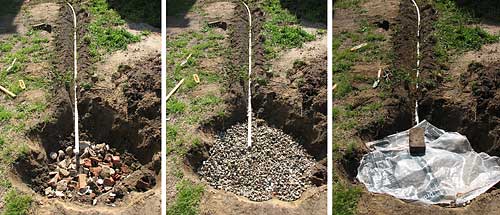
The PVC drain pipe cames into the hole right at the top of the gravel (and under the plastic, of course). I put the brick on the plastic at the end of the pipe to keep the plastic from mashing down and sealing off the end of the pipe when I backfilled the hole.
Voila! Cesspool.
With everything all buried, how will I know it's working, you might ask. I wondered the same thing. Totally hidden systems make me nervous. It works flawlessly on paper, but how will I know if something goes wrong? In the unlikely event of a system failure, the drain pipe would slowly fill with water until it backed up all the way into the attic, where the upstairs handler is located, and caused an overflow situation. If something's going wrong, I'd like to know long before that. So I've decided to go under the house and put a "T" into the last vertical section of the drain line. I'll cap off the "T" with a plug. So, when we get a really humid day and I'm wondering if the system is draining correctly, I can go under the house and remove the plug. If water flows out, then I'll know that water is backed up in the pipe. If it's empty, then I'll know everything is draining properly.  -- Bill -- Bill

From time to time it strikes me that I've done a very poor job of sharing much information about the beautiful area where we live...at the tip of Virginia's Northern Neck where the Rappahannock River meets the Chesapeake Bay.
In honor of the celebration of the 400th anniversary of Jamestown, I thought I'd share our little creek's connection to that settlement and the famed Captain John Smith.
As Smith was exploring the Bay and its tributaries he was stung by a stingray at the mouth of the Rappahannock River. Legend has it that local Indians cured the gravely ill captain with a poultice made from the mud of what is now known as Antipoison Creek. The creek on which Enon Hall was later built.
Don't know if the story's true, but the creek banks are most definitely muddy and can suck your shoe clean off. When William first heard the John Smith story years ago he decided that we should market our creek's wonderous healing mud. I still have a jar of mud that he gathered from the bank with a hand drawn label bearing the brand "Mud Brand Mud" and drawings of crabs and fish. Seven years later the mud has somehow clumped into a ball rolling around in the center of the jar. We're all rather afraid to open it. I imagine the aroma would most certainly cure whatever ails you.
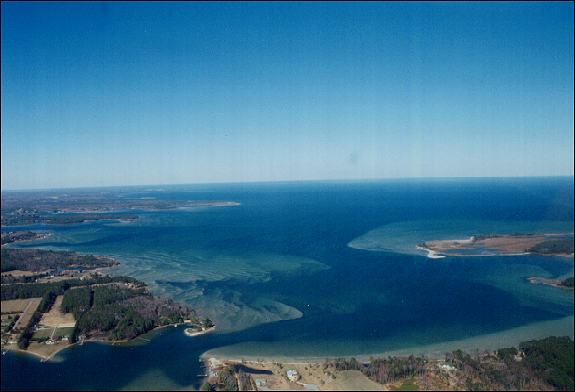
Photo by Gary Ellis
This photo, taken by our next door neighbor, shows the mouth of Antipoison Creek just left of center at the bottom. Coming out of the creek you enter first Little Bay, then the larger Fleet's Bay, and then the Chesapeake at the top of the photo. At the upper right you can see the beach where we frequently take our boat. It's a popular local destination and anchorage for sailboats traveling the Bay. When I was a child, my family spent many summer days on Little Bay because a Hathaway aunt (Lucella Hathaway Brent) owned a small house right on the beach at the bottom of the photo, just right of center. The setting for many home movies.
It's a beautiful area, but very shoaly! You have to pay attention. To see more aerial photos of our area, click here.  -- Bill -- Bill

We had a great weekend at the Battle of New Market reenactment as guests of the Signal Corps of the James.
William got to drum and take the field for 3 battles, including as a drummer for the reenactment of the actual New Market battle (on the actual battlefield) on Sunday. I was on the field working with the signalists so I missed it when he was "shot" by the Yankees and made his dramatic death fall. He said he overheard one of the officers say, "Smart drummer boy. He died in the shade."
Saturday evening, William participated in a tactical as a messenger. Because I wasn't on the field, I got to get some good photos of fighting in an orchard. William is in the white cap.
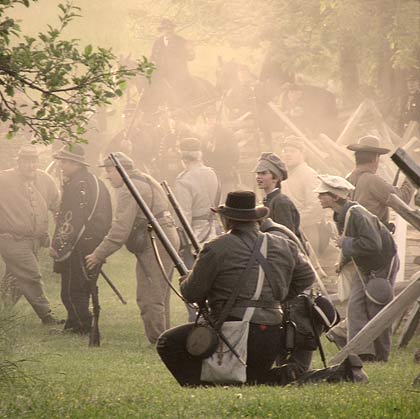
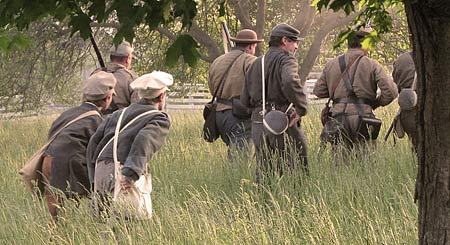
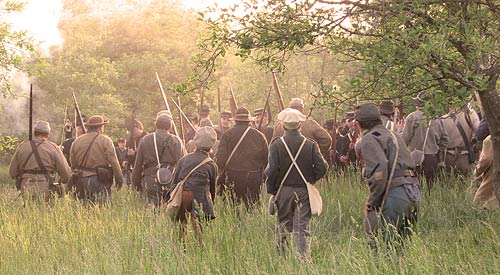
Gay went all out to get ready for the weekend, making a period dress and bonnet. 

Through the course of working on Enon Hall, Gay has certainly been no stranger to the concept of "roughing it." But this weekend was actually the first time in her life that she ever slept on the ground in a tent. And she had to do it for two nights in a row! I was a little worried about her...but she did great. -- Bill
A couple more photos, courtesy of Major Scott Dailey.


We still don't have a driveway, but that will be changing soon.
It has always been the plan for the new driveway to curve around the large red maple in the front yard in its approach to the house and garage. But then last year September Tropical Storm Ernesto stripped every leaf off of that tree leaving us wondering if it was alive or dead. Not wanting to curve the driveway around a dead tree, we decided to wait until this spring to make sure that it leafed out. Which it did.
The next challenge was tracking down our desired driveway material. We really wanted crushed oyster or clam shells for an old Colonial feel. You would think that would be easy around here, but nothing ever seems to be easy. Just down the creek from us is a seafood company with a huge pile of shucked oyster shells. In talking to them, I found out that they are presently shucking oysters from Texas and Louisiana and that they are much harder than Virginia oysters, so they won't crush when you drive on them. Instead, they'd probably slice your tires. Virginia shells are usually put back into the Bay for new oyster spat to latch onto. Clam shells are softer, in general, than oyster shells and more readily available. Clam shells are widely used for the walkways and drives in Colonial Williamsburg, so I think they're a better choice than oysters all around. I found a local source, but he doesn't crush them. The nearest source for crushed clam shells is across the Bay on the Eastern Shore. Surprisingly, the price for a large truckload (22 cu. yd.) delivered is less than buying a similar amount of gravel locally. So that's all good. 
Yesterday we plotted the path for the driveway, marking it with orange flags. The original plan was to include a 20' X 20' turnaround area near the garage to be used for guest parking, as well as enabling you to back in or out of the garage. But we weren't happy with the way that this worked. Cars parked in the turnaround were right in front of the family room windows, obstructing the view. Putting the turnaround on the other side of the drive created more problems. In addition, the location of the maple tree creates issues. In order to avoid driving over the root zone, the driveway needs to go slightly past the garage and then swing back. It just wasn't looking good and it was too hard to drive.
Our solution is a circle in front of the garage. The drive can go past the maple, turn, and then enter the circle on its right side. The circle also allows you to circle past the garage door and then back in. Or back out into the circle and then drive straight out. We've been driving it in both cars and it seems to work well. A minimum 30-foot radius is recommended for cars. We made our circle with a 33-foot radius. (I know this might be hard to follow and picture. I tried to take some photos, but the flags didn't show up well enough to be useful.)
The center of the circle will be a great place for a formal planting. We will use the clam shells to cross the circle with paths. We're talking about planting a weeping cherry in the center and maybe lining the outside with boxwoods.
Next steps: (1) we need to get a stump that's in the path ground up, (2) cut away the top 3" of topsoil and grass, (3) spread 3" of road base sand, (4) spread 2" of crushed clam shells. -- Bill

Great Grandpappy has come for a visit.
This portrait of my great grandfather, Ernest Emory Hathaway belongs to my brother, but is on loan to us for a little while. We're proud to hang him in the dining room above a piece of furniture that also belonged to him. It's always been known in the family as "Grandpappy's chest" and it got passed down the line to me.
Ernest did not live in this house, although his father (Lucellus, my gg grandfather) was born here. During Ernest's lifetime, Enon Hall belonged to his grandfather (Henry Straughan Hathaway, then his uncle (Walter Hathaway), and then to his cousin (Henry Hathaway), who sold it in 1939. Interestingly, Ernest's Uncle Walter was only 6 years older than he. That's due to the tremendous spread in the ages of the 12 children born to Henry Straughan Hathaway (my ggg grandfather) between 1847 and 1881...the oldest being Ernest's father, Lucellus. In fact, Ernest was 13 years older than his youngest uncle, Thomas Carleton Hathaway! (See Hathaway Family Tree.)
Ernest was born and raised in another house on the Enon Hall property that Lucellus built (we don't know exactly where it was) and then lived his adult life about two miles from here. He and his wife lived at and ran the White Stone Beach Hotel on the Rappahannock River until 1920. He was also in charge of the White Stone Steamboat Landing. His father, Lucellus, operated the wharf store.
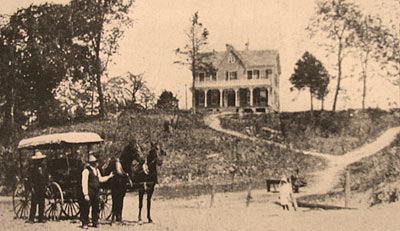
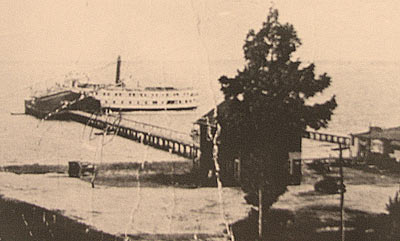
The old White Stone Beach Hotel and wharf. Sadly, the hotel was torn down several years ago.
After that, they moved a short walk away to the house on Beach Road where they lived the rest of their lives. That house now appears to be vacant.
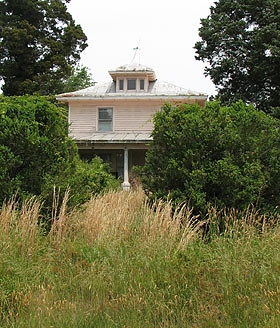
They are buried at White Stone Baptist Church, about a mile from here.
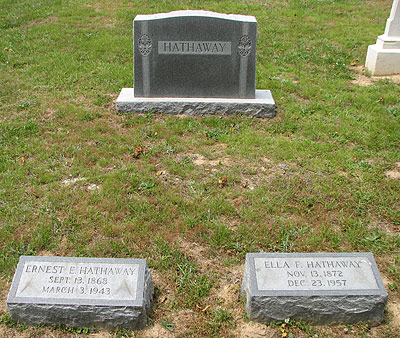
It's fun to bring his portrait back to White Stone for a visit.
A while back I posted a photo of the house finches that fell in love with our lanterns. We tried desperately to keep them from building their nests in them, but ultimately failed. We have two nests now, one with babies, and one with eggs ready to hatch any minute.

We've been really enjoyed the casement windows in the kitchen. Throwing them wide open and letting the breezes flow through.
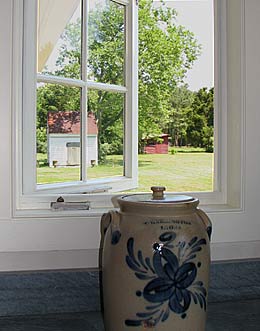
But I've had to break down and order screens for them. The problem hasn't been insects. It's the birds. The minute we open a window somewhere, the birds invite themselves in. -- Bill
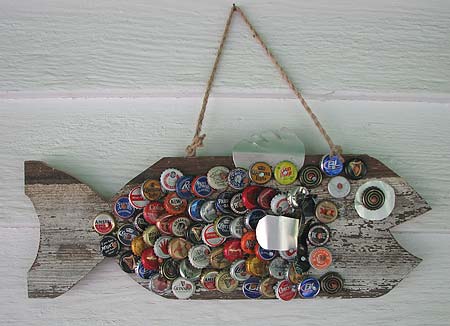
Thought I'd share this fish that William made a couple weeks ago. He saw something similar at a local farmer's market and came home wanting to make one to hang on our screened porch. He's been saving bottle caps for several years and trying to think of something to do with them. I think the fish came out pretty cool. The board is an old scrap piece of siding. He cut the fins from flashing and the scales, of course, are bottle caps nailed on with copper tacks. The Magic Hat cap made a great dizzy eye.
William and I were out earlier today and encountered this doe grazing at the side of the road. She posed pretty for me. -- Bill

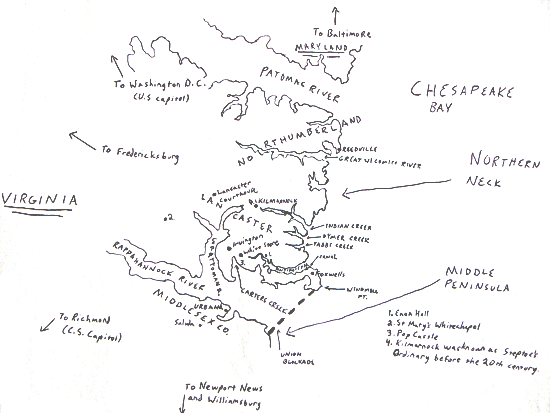
For Memorial Day, William wanted to create a page on this site devoted to the Civil War in the Northern Neck and the role of Enon Hall's Hathaways. He spent a lot of time on it this weekend and did a great job pulling together information from a number of sources and putting it all into context. The resulting article is titled, "Yankees, Blue Pigs, and a Castle: The Northern Neck and the Civil War". -- Bill
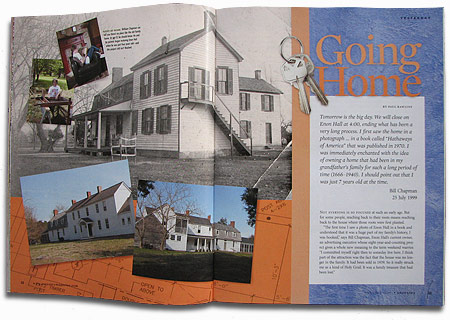
Enon Hall is featured in the May/June issue of Ancestry Magazine. We're part of an article about people reclaiming their family homes. You can read the article online by clicking on the image above. The article in the magazine is much more interesting, however, because there are lots of photos to accompany the different families' stories.
My only complaint is that I wish I had had a chance to fact check our portion before it went to press. The danger with reporters pulling information from my Journal is that the content is only as accurate as the day that I write it. I guess that's the nature of a journal or diary. For instance, when I made my first entry back in 1999 I believed, just like every other Hathaway descendant, that this land was settled by our family in 1666. Later I found out that that wasn't the case. But I don't go back and change old journal entries. I just write a new entry about that discovery. So, I wasn't aware that the author would be using my first entry that included that erroneous 1666 date. Oh well. Otherwise, we're very pleased and William appears in two nice photos. One is from the archaeological dig here in 2004 and the other I took of him recently in his new old room.
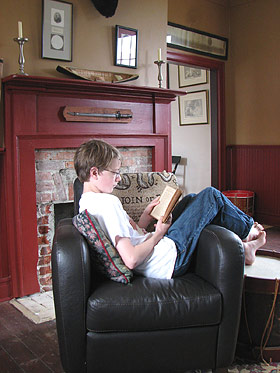
Somebody recently commented that William's room looks like "Indiana Jones' bedroom." I think they're right. -- Bill
Sometimes I really hate doing the right thing.
After Ernesto knocked down one of our cedars and took part of the graveyard wall with it (See September 2006), I started looking long and hard at the two remaining graveyard cedars.
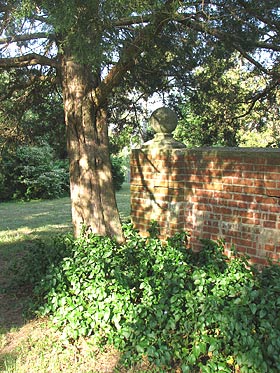
The one at the back corner outside the wall. If it fell it probably would fall away from the wall. But its upturned root ball would certainly destroy this whole corner.
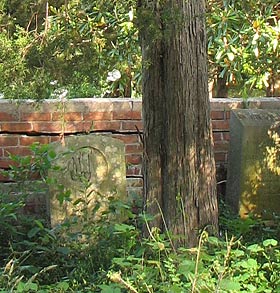
And the one inside the wall. Any direction it fell it would take out wall and possibly gravestones and boxwoods, too.
There really isn't a question of if these trees would fall. They will. Someday. It could be this summer. It could be 20 years from now. But can we really take the chance? Especially given the summer storms we've been having lately. The fact is, they never should have been planted so close to the wall in the first place. But they sure are beautiful. And it sucks to have to cut them down. To make a preemptive strike.
But it's the right thing to do.
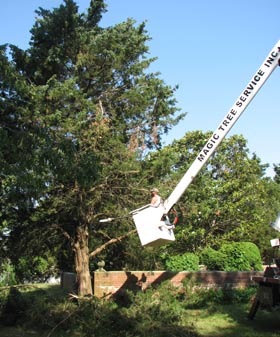
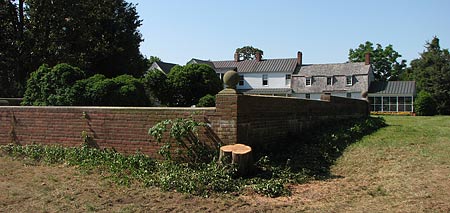
Sucks.  -- Bill -- Bill
|
 When you see this symbol, click to read related discussion in the Forum.
When you see this symbol, click to read related discussion in the Forum. 


























